Erythroid Progenitor Cells in Atlantic Salmon (Salmo salar) May Be Persistently and Productively Infected with Piscine Orthoreovirus (PRV)
- PMID: 31491892
- PMCID: PMC6784031
- DOI: 10.3390/v11090824
Erythroid Progenitor Cells in Atlantic Salmon (Salmo salar) May Be Persistently and Productively Infected with Piscine Orthoreovirus (PRV)
Abstract
Piscine orthoreovirus (PRV-1) can cause heart and skeletal muscle inflammation (HSMI) in farmed Atlantic salmon (Salmo salar). The virus targets erythrocytes in the acute peak phase, followed by cardiomyocytes, before the infection subsides into persistence. The persistent phase is characterized by high level of viral RNA, but low level of viral protein. The origin and nature of persistent PRV-1 are not clear. Here, we analyzed for viral persistence and activity in various tissues and cell types in experimentally infected Atlantic salmon. Plasma contained PRV-1 genomic dsRNA throughout an 18-week long infection trial, indicating that viral particles are continuously produced and released. The highest level of PRV-1 RNA in the persistent phase was found in kidney. The level of PRV-1 ssRNA transcripts in kidney was significantly higher than that of blood cells in the persistent phase. In-situ hybridization assays confirmed that PRV-1 RNA was present in erythroid progenitor cells, erythrocytes, macrophages, melano-macrophages and in some additional un-characterized cells in kidney. These results show that PRV-1 establishes a productive, persistent infection in Atlantic salmon and that erythrocyte progenitor cells are PRV target cells.
Keywords: PRV-1; erythroid progenitor cells; persistence; piscine orthoreovirus.
Conflict of interest statement
The authors declare no conflict of interest.
Figures
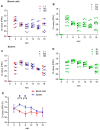


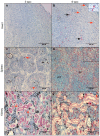
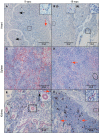
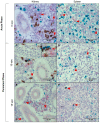
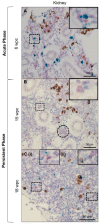
Similar articles
-
Sleeping With the Enemy? The Current Knowledge of Piscine Orthoreovirus (PRV) Immune Response Elicited to Counteract Infection.Front Immunol. 2022 Apr 6;13:768621. doi: 10.3389/fimmu.2022.768621. eCollection 2022. Front Immunol. 2022. PMID: 35464421 Free PMC article. Review.
-
Viral Protein Kinetics of Piscine Orthoreovirus Infection in Atlantic Salmon Blood Cells.Viruses. 2017 Mar 18;9(3):49. doi: 10.3390/v9030049. Viruses. 2017. PMID: 28335455 Free PMC article.
-
Piscine orthoreovirus (PRV) infects Atlantic salmon erythrocytes.Vet Res. 2014 Apr 3;45(1):35. doi: 10.1186/1297-9716-45-35. Vet Res. 2014. PMID: 24694042 Free PMC article.
-
Piscine Orthoreovirus from Western North America Is Transmissible to Atlantic Salmon and Sockeye Salmon but Fails to Cause Heart and Skeletal Muscle Inflammation.PLoS One. 2016 Jan 5;11(1):e0146229. doi: 10.1371/journal.pone.0146229. eCollection 2016. PLoS One. 2016. PMID: 26730591 Free PMC article.
-
Antiviral Responses and Biological Concequences of Piscine orthoreovirus Infection in Salmonid Erythrocytes.Front Immunol. 2019 Jan 16;9:3182. doi: 10.3389/fimmu.2018.03182. eCollection 2018. Front Immunol. 2019. PMID: 30700987 Free PMC article. Review.
Cited by
-
Piscine Orthoreovirus (PRV)-3, but Not PRV-2, Cross-Protects against PRV-1 and Heart and Skeletal Muscle Inflammation in Atlantic Salmon.Vaccines (Basel). 2021 Mar 6;9(3):230. doi: 10.3390/vaccines9030230. Vaccines (Basel). 2021. PMID: 33800725 Free PMC article.
-
Sleeping With the Enemy? The Current Knowledge of Piscine Orthoreovirus (PRV) Immune Response Elicited to Counteract Infection.Front Immunol. 2022 Apr 6;13:768621. doi: 10.3389/fimmu.2022.768621. eCollection 2022. Front Immunol. 2022. PMID: 35464421 Free PMC article. Review.
-
Piscine Orthoreovirus-1 Isolates Differ in Their Ability to Induce Heart and Skeletal Muscle Inflammation in Atlantic Salmon (Salmo salar).Pathogens. 2020 Dec 14;9(12):1050. doi: 10.3390/pathogens9121050. Pathogens. 2020. PMID: 33327651 Free PMC article.
-
Long-term persistence of piscine orthoreovirus-1 (PRV-1) infection during the pre-smolt stages of Atlantic salmon in freshwater.Vet Res. 2023 Aug 29;54(1):69. doi: 10.1186/s13567-023-01201-w. Vet Res. 2023. PMID: 37644605 Free PMC article.
-
Salmon Erythrocytes Sequester Active Virus Particles in Infectious Salmon Anaemia.Viruses. 2022 Feb 2;14(2):310. doi: 10.3390/v14020310. Viruses. 2022. PMID: 35215905 Free PMC article.
References
-
- Taranger G.L., Karlsen O., Bannister R.J., Glover K.A., Husa V., Karlsbakk E., Kvamme B.O., Boxaspen K.K., Bjorn P.A., Finstad B., et al. Risk assessment of the environmental impact of norwegian atlantic salmon farming. ICES J. Mar. Sci. 2015;72:997–1021. doi: 10.1093/icesjms/fsu132. - DOI
-
- Lovoll M., Wiik-Nielsen J., Grove S., Wiik-Nielsen C.R., Kristoffersen A.B., Faller R., Poppe T., Jung J., Pedamallu C.S., Nederbragt A.J., et al. A novel totivirus and piscine reovirus (prv) in atlantic salmon (salmo salar) with cardiomyopathy syndrome (cms) Virol. J. 2010;7:309. doi: 10.1186/1743-422X-7-309. - DOI - PMC - PubMed
-
- Palacios G., Lovoll M., Tengs T., Hornig M., Hutchison S., Hui J., Kongtorp R.T., Savji N., Bussetti A.V., Solovyov A., et al. Heart and skeletal muscle inflammation of farmed salmon is associated with infection with a novel reovirus. PLoS ONE. 2010;5:e11487. doi: 10.1371/journal.pone.0011487. - DOI - PMC - PubMed
-
- Wessel O., Braaen S., Alarcon M., Haatveit H., Roos N., Markussen T., Tengs T., Dahle M.K., Rimstad E. Infection with purified piscine orthoreovirus demonstrates a causal relationship with heart and skeletal muscle inflammation in atlantic salmon. PLoS ONE. 2017;12:e0183781. doi: 10.1371/journal.pone.0183781. - DOI - PMC - PubMed
Publication types
MeSH terms
Substances
Supplementary concepts
LinkOut - more resources
Full Text Sources

